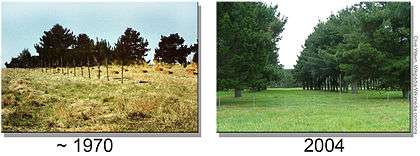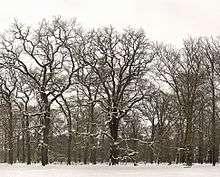Silvopasture

Silvopasture (Latin, silva forest) or wood pasture, now also known as agroforestry, is the practice of combining woodland (trees) and the grazing of domesticated animals in a mutually beneficial way. Advantages of a properly managed silvopasture operation are enhanced soil protection and increased long-term income due to the simultaneous production of trees and grazing animals. The trees are managed for high-value sawlogs, brushwood, foliage, fodder and, at the same time, provide shade and shelter for livestock and some forage, reducing stress and sometimes increasing forage production.[1]
Perhaps the oldest agroforestry system used in the temperate regions of the world, silvopastoral systems are characterized by integrating trees with forage and livestock production. Such systems have the potential to increase agricultural production in the long term. The trees have to be repeatedly pollared rather than coppiced so that the trees' re-growths are out of reach of the livestock. After hundreds of years the trees' boles become notably squat but this restriction on size gives the tree a long life.
Europe

Wood pasture is a historical European land management system in which open woodland provided shelter and forage for grazing animals, particularly sheep and cattle, as well as woodland products such as timber for construction and fuel, coppiced stems for wattle and charcoal making and pollarded poles.
United Kingdom

In the UK, there is a nationwide experiment for silvopastoral systems in which a number of tree species and planting densities are being studied over a range of sites. It is called The Silvopastoral National Network Experiment.[2] Natural England's Environmental Stewardship scheme defines Wood Pasture, in its Farm Environmental Plan booklet, as a structure of open grown or high forested trees in a matrix of grazed grassland, heathland and/or woodland floras.
Their experience shows that sheep use the trees for shelter from wind. This could provide significant animal welfare benefits. However the fact that the sheep do spend time close to trees results in greater soil compaction close to trees with the greatest compaction when trees are planted at very low densities. It is recommend that trees are planted at no less than 400 per hectare to ensure good establishment.
Evidence of old wood pasture management systems can be detected in many of the ancient woodlands of Scotland, such as Rassal Ashwood in Ross-shire,[3][4] and at Glen Finglas in the Trossachs. The Dalkeith Old Wood, belonging to the Duke of Buccleuch, where cattle still graze beneath ancient oak trees to this day is designated as a Site of Special Scientific Interest (SSSI) [4]
Aldermaston, Berkshire
Ancient veteran pollard oaks, and a couple of sweet chestnuts, in western Berkshire's Aldermaston Court's derelict wood pasture.
 Ancient pollard oak.
Ancient pollard oak. Ancient pollard oak.
Ancient pollard oak. Ancient pollard oak.
Ancient pollard oak. Ancientpollard oak.
Ancientpollard oak. Ancient pollard oak.
Ancient pollard oak. Veteran pollard oak.
Veteran pollard oak. Dead pollard oak.
Dead pollard oak. Oak
Oak Oak
Oak Oak
Oak Oak
Oak Vintage pollard oak.
Vintage pollard oak. Vintage pollard oak.
Vintage pollard oak. Vintage pollard oak.
Vintage pollard oak. Vintage pollard oak.
Vintage pollard oak. Vintage pollard oak.
Vintage pollard oak. Vintage pollard sweet chestnut.
Vintage pollard sweet chestnut. Vintage pollard sweet chestnut.
Vintage pollard sweet chestnut. Vintage pollard oak.
Vintage pollard oak. Vintage pollard oak.
Vintage pollard oak.
United States
Silvopastoral systems are definitely the most prominent agroforestry practice in the United States, particularly in the southeast.
See also
References
- ↑ "Silvopasture". National Agroforestry Center. National Agroforestry Center. 10 April 2015.
- ↑ Forum, The Farm Woodland. "The Farm Woodland Forum - Silvopastoral National Network Experiment". www.agroforestry.ac.uk.
- ↑ "Wood Pasture: Rassal Ashwood National Nature Reserve". Scottish Natural Heritage.
- 1 2 Stiven, Roland; Holl, Kate (2004). Wood Pasture. Perth, UK: Scottish Natural Heritage. ISBN 1853973866.
Further reading
- Venator, Charles R., Jurgen Glaeser and Reynaldo Soto. 1992. "A Silvopastoral Strategy" in Development or Destruction: The Conversion of Tropical Forest to Pasture in Latin America. pp. 281–292. Westview Press/Boulder
External links
| Wikimedia Commons has media related to Wood pasture. |
- National Agroforestry Center (USDA)
- Farm Woodland Forum - Silvopastoral Agroforestry
- The short film Agroforestry Practices - Silvopasture (2004) is available for free download at the Internet Archive